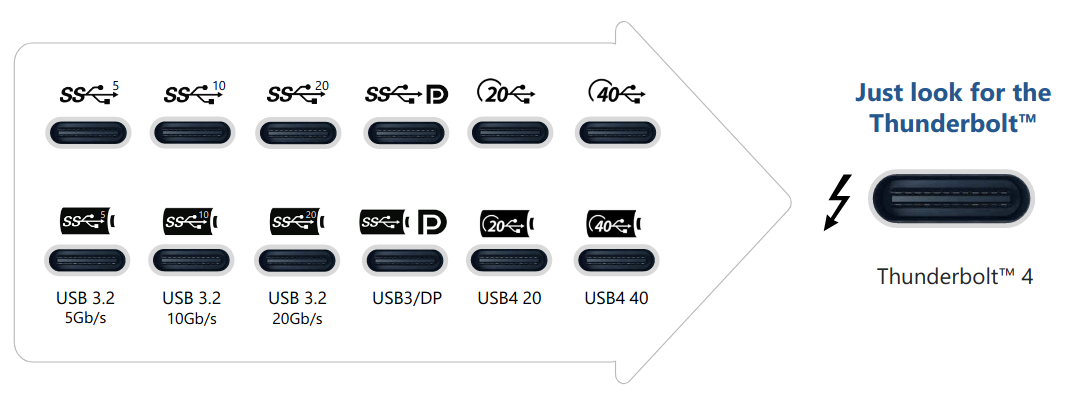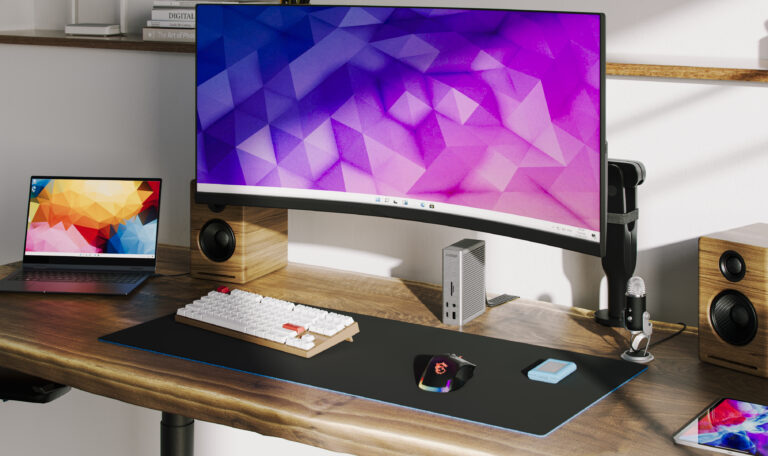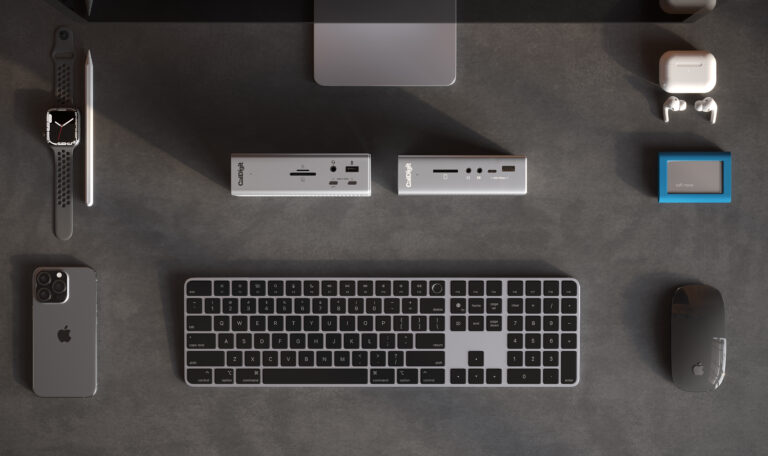As we moved from Thunderbolt 1, all the way to Thunderbolt 3, each new iteration brought with it a new level of advancement that changed the way we connect our devices.
Thunderbolt 2 allowed us to connect a 4K display whilst doubling the throughput from 10Gb/s to 20Gb/s. It wasn’t until Thunderbolt 3 that we finally were able to put aside our PSU and get power straight from our Thunderbolt devices.

Thunderbolt 3 again doubled the throughput from 20Gb/s to 40Gb/s, which allowed dock manufacturers to add 10Gb/s USB-C ports, and dual 4K 60Hz displays.
Thunderbolt 3 was the pinnacle of singles cable simplicity, and as USB also adopted the the Type-C connector, the ecosystem has flourished.
So what does Thunderbolt 4 bring to the table?
On the surface Thunderbolt 4 has a different approach. Unlike previous generations it has not doubled its throughput, keeping the same 40Gb/s that Thunderbolt 3 introduced.
Thunderbolt 4 has also not increased the monitor connectivity options either, it still supports up to 2x 4K 60Hz monitors, the same as Thunderbolt 3. The power delivery has not increased, keeping the same 100W power delivery of Thunderbolt 3.

Thunderbolt 4 has though added support for USB 4 laptops. However, Thunderbolt 3 devices will also support USB 4 when it is available via Thunderbolt technology.
So if the throughput, monitor connectivity, USB 4 support, and power delivery remain the same what are the real advantages in upgrading your Thunderbolt 3 device to Thunderbolt 4?
Much better Windows PC Support
A lot of the changes are geared towards Windows PCs and for PC manufacturers to fully support the Thunderbolt specification.
At the moment a Thunderbolt 3 PC laptop manufacturer can restrict the amount of monitors a user can connect to their laptop’s Thunderbolt 3 port from 2 monitors to 1 monitor. With Thunderbolt 4, PC manufacturers have to allow dual monitor support by default.

As another example, PC manufacturers can restrict power delivery on their Thunderbolt 3 port in order to prevent laptop charging. With Thunderbolt 4, manufacturers have to allow power delivery from at least one port.
On macOS this is not an issue since Apple’s Thunderbolt 3 ports fully support the Thunderbolt 3 specification.
A lot of the upgrades to Thunderbolt 4 are really just enforcements to make sure PC manufacturers fully adopt the Thunderbolt specification, as these were not enforced during the the Thunderbolt 3 era.
PCIe 32Gb/s
One other upgrade announced for Thunderbolt 4 is the use of 32Gb/s PCIe, and the ability to connect an NVMe SSD with speeds up to 3000MB/s.
On the surface this seems like a big upgrade, but actually Thunderbolt 3 has offered 32Gb/s PCIe for years. However, Thunderbolt 4 has made 32Gb/s the minimum requirement.

This has not been an issue on macOS since Thunderbolt 3 has always offered 32Gb/s PCIe. On the Windows side, PC manufacturers have been required to offer a minimum of 16Gb/s PCIe on their Thunderbolt 3 port without having to offer 32Gb/s.
With Thunderbolt 4, laptop manufacturers have to implement the full 32Gb/s PCIe technology as standard. If you are a NVMe SSD user on macOS you will not see a big difference in performance between Thunderbolt 3 and Thunderbolt 4. Even PC users that have Thunderbolt 3 ports with 32Gb/s PCIe will not see much performance difference.
More Thunderbolt Ports – Same 40Gb/s Bandwidth
Really the main upgrade to Thunderbolt 4 is the inclusion of 4x Thunderbolt ports allowing you to connect more Thunderbolt specific devices to your docks and hubs. However, as Thunderbolt 4 still retains the 40Gb/s performance, those 4x Thunderbolt ports don’t have increase bandwidth to work with.

What this tells us is that Thunderbolt 4 devices, such as docking solutions, will not be that much different to the docks we see today. The performance, monitor connectivity, and power delivery will all be the same.
A Small Step Forward
By purchasing a Thunderbolt 3 product today you are future-proofing your device for when Thunderbolt 4 is eventually available.
CalDigit’s flagship TS3 Plus for example will provide the majority of features a Thunderbolt 4 dock does and be compatible with Thunderbolt 4 and USB 4 laptops.

In conclusion, it will be some time before we start to see Thunderbolt 4 laptops, and even then, they will most likely be Windows PCs geared towards high-end users in late 2020.
Thunderbolt 4 may not be the giant leap forward we were expecting but a small improvement on Thunderbolt 3.







